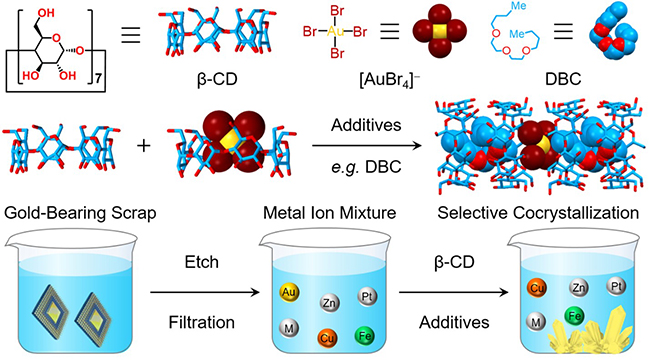A research article entitled “High-Efficiency Gold Recovery by Additive-Induced Supramolecular Polymerization of β-Cyclodextrin” has been published in Nature Communications by Postdoctoral Fellows Huang Wu and Yu Wang, collaborating with Professor Wenqi (Vince) Liu from the University of South Florida.
It has been a decade since the Stoddart group first employed cyclodextrins (CDs) to recover gold. CDs, an eco-friendly class of macrocycles, are cyclic oligosaccharides with hydrophobic inner cavities. In 2013, the group reported the rapid, spontaneous co-precipitation of α-CD and [AuBr4]– anions in water, an observation which enables the establishment of an eco-friendly gold recovery protocol without involving highly toxic [Au(CN)2]– anions. This work was published in Nature Communications (Nat. Commun. 2013, 4, 1855). In the most recent Nature Communications paper (Nat. Commun. 2023, 14, 1284), an improved gold recovery protocol has been demonstrated based on an additive-induced crystallization between cost-effective β-CD and [AuBr4]– anions. The additives initiate a rapid assembly process by co-occupying the binding cavity of β-CD along with the guest [AuBr4]– anions, leading to the formation of supramolecular polymers that precipitate from aqueous solutions as nanocrystals. The gold recovery efficiency reaches 99.8% when dibutyl carbitol is employed as the additive. The efficiency is much higher than that (78.3%) obtained in a previous method using α-CD. In a laboratory-scale gold-recovery protocol, over 94% of gold was recovered from electronic waste at gold concentrations as low as 9.3 ppm. This fast cocrystallization process constitutes an attractive strategy for the practical recovery of gold, and leads to significantly reduced energy consumption, cost inputs, and environmental pollution.
This gold recovery journey with cyclodextrin has been featured in the latest issue of Nature Communications (Nat. Commun. 2023, 14, 1283). A Comment Article, entitled “Application of Cyclodextrins as Second-Sphere Coordination Ligands for Gold Recovery”, written by Professor Eric Monflier and Anne Ponchel at the University of Artois, notes that “Focusing on gold separation, pioneering results have been highlighted by Stoddart et al. in 2013 using α-CD and KAuBr4…Ten years after their first work on gold recovery, Stoddart et al. achieved a new important step forward to recovering gold from waste, with almost 100% efficiency, by developing an additive-induced supramolecular co-precipitation process based on the use of β-CD as a second-sphere ligand…In light of the above results, it appeared that supramolecular science, especially based on renewable natural cyclodextrins, reached a level of maturity that enables a paradigm shift…Their construction based on the non-covalent binding of β-CD and metal complexes opens the way for innovative and disrupting devices in technologically-important fields.”
Pictured below – Graphical representations of the high-efficiency gold recovery using β-CD:


